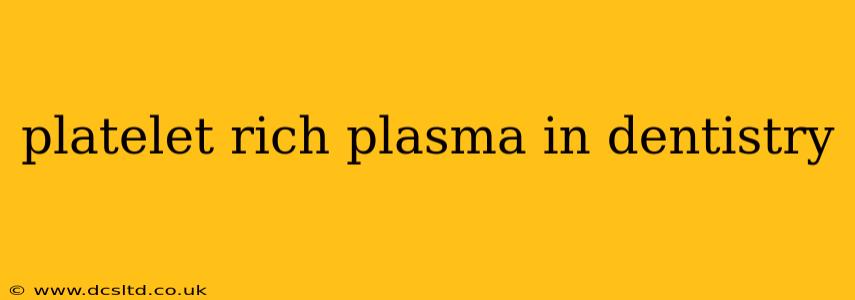Platelet-rich plasma (PRP) therapy has revolutionized various medical fields, and dentistry is no exception. This innovative treatment harnesses the body's natural healing capabilities to promote faster and more effective tissue regeneration. This comprehensive guide explores the use of PRP in dentistry, addressing common questions and concerns.
What is Platelet-Rich Plasma (PRP)?
PRP is a concentration of platelets derived from a patient's own blood. Platelets are blood cells crucial for clotting; however, they also contain a wealth of growth factors—proteins that stimulate cell growth and tissue repair. The process involves drawing a small amount of the patient's blood, centrifuging it to separate the platelet-rich plasma from other blood components, and then injecting this concentrated PRP into the targeted area.
How is PRP Used in Dentistry?
PRP finds application in various dental procedures, including:
- Socket preservation: After tooth extraction, PRP can be applied to the extraction socket to accelerate bone regeneration and reduce the risk of bone loss. This is crucial for future implant placement.
- Guided bone regeneration (GBR): In cases of significant bone loss, PRP can be combined with bone grafting materials to enhance bone regeneration and provide a stable foundation for dental implants or restorations.
- Periodontal regeneration: For individuals with gum disease (periodontitis), PRP can help regenerate damaged gum tissues and bone, improving periodontal health and reducing inflammation.
- Sinus lift: During a sinus lift procedure (used to augment bone in the upper jaw for implants), PRP can be incorporated to improve bone formation and integration.
- Implant placement: PRP can be used during implant surgery to accelerate osseointegration (the fusion of the implant with the surrounding bone) and enhance implant stability.
- Soft tissue grafting: PRP can be utilized to accelerate healing and improve the aesthetic outcome of soft tissue grafts used to correct gum recession or improve the appearance of the gums.
What are the Benefits of PRP in Dentistry?
The benefits of using PRP in dentistry are numerous:
- Faster healing: PRP's growth factors significantly accelerate the healing process, reducing recovery time.
- Reduced inflammation: PRP helps reduce inflammation and swelling, promoting faster comfort and improved aesthetics.
- Improved tissue regeneration: PRP stimulates the regeneration of bone, gum tissues, and other structures in the mouth.
- Enhanced implant success rates: PRP enhances osseointegration, leading to more predictable and successful implant outcomes.
- Minimally invasive: The procedure is minimally invasive, using the patient's own blood, minimizing the risk of allergic reactions or rejection.
What are the Risks and Side Effects of PRP in Dentistry?
While generally safe, PRP therapy does carry some potential risks and side effects, although they are infrequent:
- Pain or swelling at the injection site: Mild pain or swelling is common and typically resolves quickly.
- Bleeding or bruising: Some bleeding or bruising at the injection site is possible.
- Infection: Although rare, infection is a possibility, as with any injection procedure.
Does PRP Treatment Hurt?
The level of discomfort during PRP injection varies depending on individual pain tolerance and the treatment area. Most patients report minimal discomfort, similar to a routine injection. A local anesthetic may be used to further reduce any discomfort.
How Long Does PRP Treatment Take?
The duration of the PRP procedure itself is usually relatively short, typically less than an hour. The complete healing process, however, depends on the specific procedure and the individual's healing capacity.
How Much Does PRP Treatment Cost?
The cost of PRP treatment in dentistry can vary depending on the specific procedure, the dentist's fees, and the patient's location. It's best to consult with your dentist to obtain a personalized cost estimate.
Is PRP Treatment Covered by Insurance?
Insurance coverage for PRP treatment varies widely depending on the insurance provider and the specific procedure. Some insurance plans may cover part or all of the cost, while others may not. It is crucial to check with your insurance provider to determine your coverage.
Conclusion:
PRP therapy offers a promising approach to enhancing various dental procedures. By harnessing the body's natural healing potential, it promotes faster healing, improved tissue regeneration, and greater success rates for certain treatments. However, it's essential to consult with a qualified and experienced dentist to determine if PRP therapy is appropriate for your individual needs and to understand the potential risks and benefits. Remember to discuss costs and insurance coverage before proceeding.
